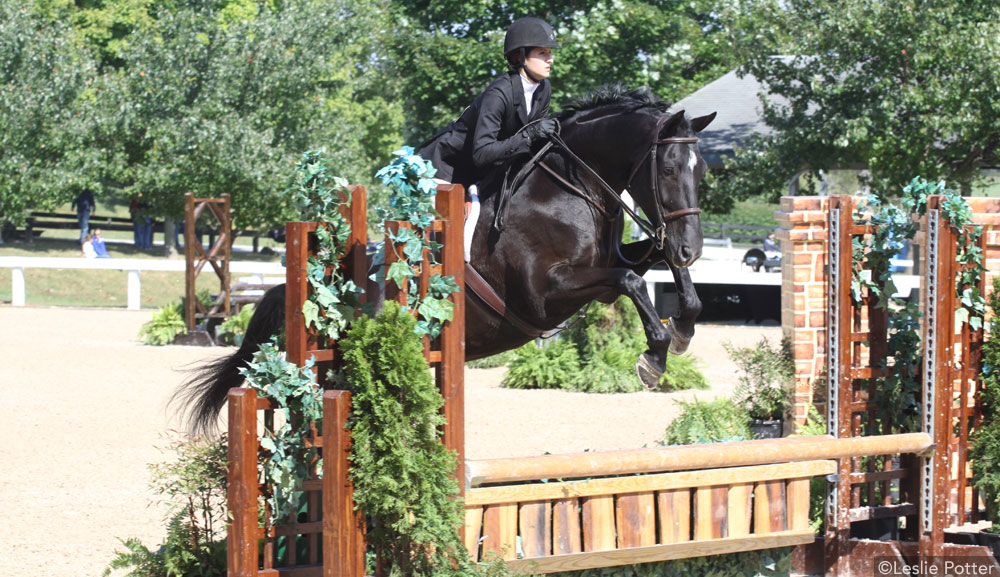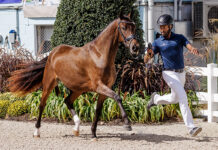Meg Schulman is one of the USEF’s most popular and respected judges in the hunter and equitation divisions. She also finds time to conduct clinics throughout the United States, sharing her expertise with competitors eager to improve their horsemanship skills. At a recent clinic in California, Meg shared four tips on how hunt seat equitation riders can impress the judge.

- Develop a tight, secure lower leg: “When I’m judging an equitation class,” Meg said, “the first place I look is the rider’s lower leg. The heel should be down. The rider’s calf should be in contact with the horse’s side, just at or slightly behind the girth. The lower leg must also be tight, because it’s the base of the rider’s security and support when jumping. A swinging lower leg tells me that the rider has an insecure seat. In fact, the judge’s eye is drawn to movement. Judges really notice it if a rider fidgets with their foot in the stirrup or allows their lower leg to continually slip too far back.”
- Practice smooth transitions: Meg emphasized that riders can drop several ribbon placings—or end up out of the ribbons altogether—if they execute sloppy transitions. Instead, Meg offered, riders should keep their horse on their aids so that the horse is always prepared, mentally and physically, for the next gait. “The horse should always remain balanced so that instead of abrupt transitions there is a blending from one gait to the next. For example, riders need to use their lower leg with downward transitions, rather than simply pulling back on the reins. By adding some lower leg, the horse remains round instead of being heavy on its forehand. As a judge, I want the horse’s body shape to be consistent: no flipping of its head, no hollowing of its back. Every transition should be seamless.”
- Be an effective rider: “As riders move up into the upper levels of equitation, the judge expects more than just a good position,” Meg explained. Once riders graduate from short stirrup and novice hunt seat classes, they’re expected to do more. “At the upper levels, everyone has a good position. But as a judge, I want to see someone who does more than just sit well or pose on a horse. That means I’ll ask you to collect and lengthen your horse’s stride. I expect to see your horse consistently on your aids, on the bit. I want to see a rider.”
- Pay attention to your turnout: Meg took a few minutes to address a rider’s appearance. Though she isn’t impressed by trendy apparel or accoutrements, she does believe that equitation riders should make an effort to look their best. “You don’t have to have the most expensive tack, equipment or clothing, but it must be neat and clean. Dust off your boots. Never, ever come into an equitation class with twisted reins or twisted stirrup leathers. Check the keepers and sliders on your horse’s bridle so that there isn’t a lot of flapping leather straps. Overall,” Meg said, “make it look as if you care.”
Further Reading
Hunt Seat Equitation Challenge: Sitting Trot
Perfecting the Posting Trot







Thanks for this- I have been riding for years but it’s nice to have a little reminder every now and again on little things to remember to do!
That’s good advice about the lower leg. I’m working on improving that right now because of an injury. One has to have strength.
Great advice! And yes, a bit of good flatwork is still the basis of everything!!
Thats great! Especially the leg part, I do have an insecure seat. Rode western and now getting into english, kind of tough if you ask me!
I love articles with advice from judges so I know what they are looking for.
thanks for the great advice this will help me in the show ring and it’ll also help me ride my greenie more effectively and maybe stay in the saddle longer:)
Nice horse show secret. In the lineup never, ever go to the ends on either side. The judge will look more favorably on you if you are in the middle of the lineup!! Heard this from a big judge in new england. thanks.
This is a helpful article, but I REALLY want to see more articles about getting your horse to be on the aids, getting your horse to listen to you, and perfecting downward transitions, especially. Otherwise, this article has useful information, and could help improve an equitation ride.
Wow! Great article. I noticed the very first thing she said was that she looks at the lower leg and “the heel should be down.” Of course we all know this is important to balance but can be difficult. I just purchased a pair of EquiHeels to help improve that piece of my equitation. It comes with some ebooks on exercises to help improve heels down and equitation over time so that I won’t have to rely on aids like EquiHeels. If any else has the same problem, you can check out http://www.equiheels.com
Thanks for the advice.